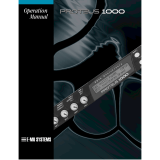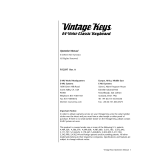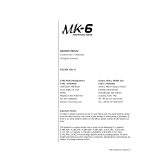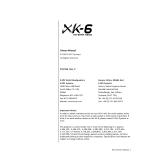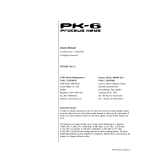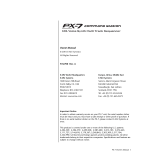Page is loading ...

3-862-747-11(1)
© 1998 by Sony Corporation
Multi-Effect
Processor
DPS-V55M
Operating Instructions
Mode d’emploi
Bedienungsanleitung
GB
GB
F
D

2
GB
WARNING
To prevent fire or shock
hazard, do not expose the
unit to rain or moisture.
WARNING
To prevent shock hazard, do not insert the
plug cut off from the mains lead into a
socket outlet. This plug cannot be used and
should be destroyed.
Voor de klanten in Nederland
Bij dit produkt zijn batterijen
geleverd. Wanneer deze leeg
zijn, moet u ze niet weggooien
maar inleveren als KCA.
VARNING
Explosionsfara vid felaktigt batteribyte.
Använd samma batterityp eller en
ekvivalent typ som rekommenderas av
apparattillverkaren. Kassera använt batteri
enligt fabrikantens instruktion.
ADVARSEL!
Lithiumbatteri – Explosionsfare ved
fejlagtig handtering.Udskiftning må kun
ske med batteri af samme fabrikat og type.
Levér det brugte batteri tilbage til
leverandøren.
VAROITUS
Paristo voi räjähtää, jos se on virheellisesti
asennettu. Vaihda pariso ainoastaan
laitevalmistajan suosittelemaan tyyppiin.
Hävita käytetty paristo valmistajan
ohjeiden mukaisesti.
ADVARSEL
Eksplosjonsfare ved feilaktig skifte av
batteri. Benytt samme batteritype eller en
tilsvaende type anbefalt av
apparatfabrikanten. Brukte batterier
kasseres i henhold til fabrikantens
instruksjoner.

3
GB
Getting Started
Main Features 4
How to Use This Manual 4
Functional Hierarchy 5
Names and Functions of Parts 6
Understanding the Effect Types and Program Structures 8
Hooking Up 9
Basic Operations
Choosing a Program 10
Reading the Display 11
Outputting Without Effects (BYPASS) 11
Choosing a Program by Effect Type 12
Editing a Program
Choosing the Effects 13
Choosing a Structure 14
Changing Effect Parameters 14
Using the TAP Function 15
Saving Processed Effects 16
System Operations
MIDI Settings 17
Other Settings 18
Additional Information
Restoring the Original Factory Settings 19
Replacing the Memory Back-up Battery 19
Troubleshooting 19
Precautions 20
Specifications 20
MIDI Implementation Chart (Inside Back Cover)
Blank Chart (Back Cover)
Table of Contents
GB
Welcome!
Thank you for purchasing the Sony Multi-
Effect Processor. Before operating the unit,
please read this manual thoroughly and
retain it for future reference.

4
GB
Getting Started
Main Features
The DPS-V55M is a four channels multi–effect processor.
Four channel construction
The DPS-V55M is outfitted with four inputs (and outputs) and can
route the input signals in a variety of different ways depending on
the chosen effect algorithms and program structures.
Flexible effect algorithms and program structures
The DPS-V55M incorporates a total of 45 different effect
algorithms divided into three different types: 4ch, 2ch (stereo),
and Mono-Pair. Each effect contains several adjustable parameters
and can be easily modified. In addition 2ch and/or Mono-Pair
effects can be used in combination within a program, and the
program structure can be switched between serial and parallel,
allowing you to take full advantage of the four channel
construction.
User-friendly operating environment
A primary concern when creating the DPS-V55M, was to provide
an intuitive operating system for creative sound control. All effect
parameters can be accessed directly using the EDIT PARAMETER
buttons.
Large memory banks
In addition to the 200 different preset programs (numbers
001~200) created by musicians and engineers from around the
world (preset memory), there is also room for you to store up to
200 of your own original programs in the user memory (numbers
201~400). We've also included a search function so you can recall
the programs you need without having to remember their
program numbers.
Search function
The search function lets you locate programs you want by
specifying the type of effects they contain. (See page 12.)
TAP function
The TAP function lets you adjust certain parameters or trigger
certain effects simply by tapping on the ENTER (TAP) button. (See
page 15.)
MIDI compatibility
The MIDI interface lets you conduct program change and data
save operations. (See page 17.)
How to Use This Manual
These operating instructions describe setup and operating
procedures for the DPS-V55M multi–effect processor.
Before using this unit we do recommend taking a glance at the
“Functional Hierarchy” chart on page 5 and reading
“Understanding Effect Algorithms and Program Structures” on
page 8 to familiarize yourself with the unit.
“Hooking Up” shows you how to make different kinds of
connections between this unit and instruments, mixers, and/or
components.
The remaining chapters show you how to operate the unit. Refer
to each as necessary.
For specific information regarding the individual effects and
parameters, refer to the separate “Effect Parameter Guide.” For
information regarding the preset memory, refer to the separate
“Preset Memory Catalog.”
• The following icon is used in this manual:
z Indicates hints and tips for making the task easier.

5
GB
PLAY
Effect On/OffEDIT
Master Level
FxA On/Off
FxB On/Off
Parameter 1
*
*
*
Parameter n
Master Level (0 ~ 100)
FxA
Program NumberSAVE
Execute
Program Name
Parameter 1
*
*
*
Parameter n
FxB
FxTYPE
Effect A Type Number
Effect B Type Number
Fx Type
Effect Type Number
Execute (push ENTER)
Search
Structure Type
Program Number
Program number
Tap Function
Bypass or Muting
TAP
BYPASS
Channel (1 ~ 16)
SYSTEM
Out/Thru (Out/Thru)
MIDI
Program Change Table (Prog #, #)
Omni Mode (On/Off)
Bulk Trans (From, To)
Tap Mode (x / / x / / x / / x1 / x2 / x3)
Bypass Mode (Bypass/Muting)
Set Up
1
4
1
3
1
2
Functional Hierarchy

6
GB
Getting Started
Names and Functions of Parts
1 U (Power switch)
Press this switch to turn the power on and off. Turning
on the power on recalls the last used memorized effect
and activates play mode automatically.
2 Effect algorithm list
Numbers and names of the 45 available effect
algorithms. 01~09 are 4ch algorithms, 10~36 are 2ch
algorithms, and 37~45 are Mono-Pair algorithms. (See
“Understanding Effect Algorithms and Program
Structures” on page 8 for details).
3 Input level indicators
Light green, orange, or red to indicate strength of the
signal input to the respective channel (1~4).
Green = –30 to -6 dB; Orange = –6 to –2 dB; Red = clip
(greater than –2 dB).
4 Display
Displays various information such as program
numbers, program names, effect numbers, effect
names, structures, parameter values, etc.
5 Fx TYPE (SEARCH) button
Use to select an effect type or program structure.
Also use to search for program by effect type (see page
12).
6 BYPASS button
Press to turn the selected program on or off. (Can also
be set to mute the output of the processor, see page 18.)
7 SAVE button
Use this button to save a customized program.
8 SYSTEM button
Use this button to access the MIDI and system setup
parameters.
9 Rotary encoder
Use to select program numbers and make adjustments
to parameter settings.
10 MIC IN jack
Use to connect a microphone with either an XLR or
phone type connector.
Microphone assign switch
Use select which channel the signal input to MIC IN
jack will be assigned to.
CH-1: to channel 1 (signals input to the INPUT 1 jack
on the rear panel are muted);
CH-1+2: to channels 1 and 2 (signals input to the
INPUT 1 and 2 jacks on the rear panel are muted);
REAR: input from the MIC IN jack is muted and only
the sound input to the rear inputs (1~4) is processed.
MIC GAIN level adjustment knobs
Turn the knob to the left or right to adjust the input
level of the signal input to the MIC IN jack (up to 40
dB).
11 INPUT LEVEL adjustment knobs
Turn the knob to the left or right to adjust the input
level of the respective channel (1~4). The input level
can be increased up to 12 dB above unity* without
clipping.
* When the input and output levels are the same. (On this
unit, unity is achieved when the mark on the INPUT
LEVEL knob is pointing toward the large index mark
(located at approximately 1 o’clock).)
12 EDIT PARAMETER (SKIP) buttons
Use to select the parameter you want to adjust when
customizing an effect.
Press both buttons at the same time to skip to another
parameter group, see page 14.
13 EXIT button
Press to return to the play mode.
14 ENTER (TAP) button
Use to confirm SAVE operations (etc.).
Also use as a trigger, or to set time-variable parameters
(see page 15).
Front panel
2
3
11
10
13
14
12
4
6
5
7
8
9
1

7
GB
Names and Functions of Parts
Rear panel
1 LCD CONTRAST knob
Use to adjust the contrast of the display on the front
panel.
2 MIDI OUT/THRU terminal
For sending and/or relaying MIDI command signals
from the processor to other components. To switch
between OUT and THRU, see pages 17~18.
3 MIDI IN terminal
Input for MIDI command signals. Use a commercially
available MIDI cable to connect this terminal to another
component's MIDI OUT (or THRU) terminal.
4 OUTPUT jacks (1~4)
Standard output jacks for channels 1, 2, 3, and 4.
Connect to and amplifier or mixer (etc.).
Jacks are divided into two groups:
GROUP A (1 (L) and 2 (R))
GROUP B (3 (L) and 4 (R))
Output level selector
Use to set the output level of the OUTPUT jacks to
match the input level of the connected equipment.
You can select a +4 dBu or –10 dBu output level.
This setting effects all jacks (1, 2, 3, and 4).
5 INPUT jacks (1~4)
Standard input jacks for channels 1, 2, 3, and 4.
Connect to mixer, CD player, or keyboard (etc.).
Jacks are divided into two groups:
GROUP A (1 (L/MONO) and 2 (R))
GROUP B (3 (L/MONO) and 4 (R))
When inputting a monaural signal, use the 1 or 3
(MONO) jacks. The signal is sent to both of the
channels in the respective group.
Input level selector
Use to set the input level of the INPUT jacks to match
the output level of the connected equipment.
You can select a +4 dBu or –10 dBu input level.
This setting effects all jacks (1, 2, 3, and 4).
6 AC power cord
Connect to an AC power outlet.
2
3
4
5
1
6

8
GB
Effect algorithms
This unit contains three types of effect algorithms: 4ch, 2ch,
and Mono-Pair.
The 4ch effects (algorithms # 01~09) are designed to handle
four channels simultaneously. These are also the highest
quality effects. Consequently, programs containing these
effects can not contain any other effects.
2ch effects (algorithms # 10~36) and Mono-Pair effects
(algorithms # 37~45), on the other hand, are designed to
handle two channels simultaneously and can be used in
various combinations within a program. Each program can
contain two 2ch effects, two Mono-pair effects, or one 2ch
effect and one Mono-Pair effect.
The 2ch effects are “traditional” stereo effects.
Mono-Pair effects are combinations of two parallel mono
effects (one for each channel).
Program structures
Each program can contain up two effects (FxA and FxB)
depending on the type of effect selected.
If a 2ch or Mono-Pair effects are selected, the program
contains two effects (one, or both can be turned off if
necessary). When a program contains two effects, the way
the unit routes the signals through the effects is controlled
by the program structure. There are two possible program
structures: parallel (/) and serial (m).
Parallel (/) program
FxA and FxB are completely independent.
Serial (m) program
The sound from FxA is fed into FxB for further
processing before being output.
If a 4ch effect is selected, the program contains only one
effect (the other effect is automatically disabled).
Example of program containing a 4ch effect
FxA only
Understanding Effect Algorithms and Program Structures
Getting Started
Mono-Pair
n
n
4ch
n
n
n
n
2ch
n
n
n
n
n
n
FxA
1
2
3
4
1
(10~45)
(10~45)
2
3
4
FxB
n
n
1
3
1
(09~40)
3
n
22
n
44
FxB
FxA
(01~09)
FxA
1 + 3
2 + 4
n
n
FxB
1, 3
2, 4
(10~45) (10~45)

9
GB
• Before connecting this unit to another device, be sure to unplug the AC power cord from the power outlet.
• Turn off the power switch on this unit and all components to be connected, such as keyboards and active speakers
(speakers with built in amplifiers).
• After all the connections, double check that the connections are correct before plugging the AC power cord back into the
power outlet.
• If the connected components output large signals that cause distortion, adjust the INPUT LEVEL knobs on this unit to lower
the input level, or lower the output level of the connected component.
Example 1: Hooking up to instruments
Hooking Up
Example 3: Hooking up to a mixer (cutting the direct sound) (Stereo send, Stereo Return)
When using the processor in a send-return loop
• When using effect that have an effect level parameter, we recommend setting the direct sound to “0” so that only the sound of the
effect will be output.
• We also recommend setting the BYPASS function to “Muting” (as shown on page 18).
Example 2: Hooking up a mixer (Mono send, Stereo return)
Electric Guitar
Guitar Pre-Amplifier
IN
DPS-V55M
OUT
Mixer (MDM-X4, etc..)
Active
Speaker
Active
Speaker
IN
MIDI IN
Keyboard
DPS-V55M
Effect Return
(Stereo x 2)
Effect Send
(Monox2)
OUTIN
Mixer (MDM-X4, etc..)
Active
Speaker
Active
Speaker
Microphones
IN
DAT Recorders
CD Players
Audio Mixing Console
etc
etc
Power Amplifier
Main Monitor Speaker System
Effect Send
(Stereo x 2)
Effect Return
(Stereo x 2)
OUT
DPS-V55M

10
GB
Choosing a Program
The processor comes with 200 different preset programs
(numbers 001~200) as well as room for 200 user programs
for storing the programs you create (numbers 201~400). Use
the following procedure to choose the program you desire.
1 Press U to turn on the power.
After a few seconds, the play mode screen appears.
2 Turn INPUT LEVEL (1~4) to adjust the input
levels.
If an input level indicator lights red (clip), the input
level for that channel is set too high. Be sure to set the
input level correctly since it has a direct relationship to
the quality of the effects (see page 6 for details).
Basic Operations
Level indicators Display
Rotary encoder
3 Turn the rotary encoder to select a
program (001~400).
The program numbers (and corresponding names)
appear in the display as you turn the jog dial.
Before you turn on the connected components
Be sure to turn the volume level down to avoid an unexpected
output of massive volume.
You can also search programs by effect type
See page 12 for details.
001 Super Reverb
FxA:11/ FxB:12
INPUT LEVEL123 4
U
INPUT LEVEL (1~4)

11
GB
Reading the Display
During play mode the display provides various information
about the selected program
1 Program number and name:
The number (001~400) and name of the current program .
2 FxA On/Off symbol:
“•” : FxA is on (in the illustration, FxA is on).
(Blank) : FxA is off
3 FxA effect number:
The number (01~45) of the effect assigned to the current
program’s FxA block.
The effect numbers correspond to those printed on the front panel
to the left of the display. When a 4ch effect is assigned to the FxA
block, the FxB effect number and the structure symbol do not
appear in the display.
4 Structure symbol:
“/” (Parallel) : To use FxA and FxB separately (the
illustration shows a parallel structure).
“m” (Serial) : To feed the output of FxA into FxB for
additional processing.
The structure symbols correspond to those printed on the front
panel below the display. (See page 8 for details.)
5 FxB On/Off symbol:
“•” : FxB is on
(Blank) : FxB is off (in the illustration, FxB is off).
6 FxB effect number:
The number (10~45) of the effect assigned to the current
program’s FxB block.
The effect numbers correspond to those printed on the front panel
to the left of the display.
Outputting Without Effects (BYPASS)
The bypass function allows you to output the original signal
without adding any effects. This function can also be set to
completely cut (mute) the sound output from the processor
(see page 18 if you want to switch to muting).
Press BYPASS to activate the bypass (mute)
function.
“BYPASS” (or “MUTING”) appears in the display.
Press again to cancel and output with effects.
<< BYPASS >>
001 Super Reverb
FxA:11/ FxB:12
234 651

12
GB
Basic Operations
1 Press Fx TYPE (SEARCH) twice to display
the search screen.
2 Turn the rotary encoder to select an effect
(01~45).
The numbers (01~45) and names of the effects
correspond to those printed on the front panel to the
left of the display.
The number and name of the first program containing
the selected effect appear on the bottom line of the
display.
You can also monitor the sound of this program.
3 Press EDIT PARAMETER / to move the
cursor to the bottom line of the display.
4 Turn the rotary encoder to select a
program.
Only programs containing the selected effect
(displayed on the first line) will appear.
You can also monitor the sound of these programs.
5 Press ENTER (TAP) to switch to the
selected program.
“Executing” appears momentarily and the unit
switches to the selected program (and back to play
mode).
Selecting Programs by Effect Block
This function lets you search for programs based on the type of effects they contain. In addition to being a good way to
explore different implementations of the same effect, it is also a quick way locate a specific program.
Effect algorithms Display Rotary encoder
Search:01 Plat1
098 Super Reverb
Search:03 Room1
017 Sound Fx
Search:03 Room1
017 Sound Fx
Search:03 Room1
147 Other Progrm
147 Other Progrm
FxA:03
ENTER
(TAP)
FxTYPE
(SEARCH)
EDIT PARAMETER
? /

13
GB
1 Press Fx TYPE (SEARCH) to display the type
screen.
2 Turn the rotary encoder to select the
effect (01~45) for FxA.
The numbers (01~45) correspond to the effects printed
on the front panel to the left of the display.
When you select a 4ch effect (numbers 01~09), press
EXIT to return to play mode and skip the following
steps.
3 Press EDIT PARAMETER / twice to move
the cursor to FxB.
Note: this is not possible if you select a 4ch effect
(01~09) in the previous step.
Editing a Program
Choosing the Effects
Use the following operations to choose the effect(s) to be used in your program. You can choose up to two effect blocks
(when using 2ch (10~36) or Mono-Pair (37~45) effects). When using a 4ch effect (01~09), you may choose only one effect.
(See page 8 for details).
4 Turn the rotary encoder to select an effect
(10~45) for FxB.
The numbers (10~45) correspond to the effects printed
on the front panel.
5 Press EXIT to return to play mode.
To change the structure type before returning to the
play mode, press EDIT PARAMETER ? to switch to
the structure parameter, then proceed from step 3 of
“Choosing the Structure”.
EXIT
FxTYPE
(SEARCH)
EDIT PARAMETER
? /
Effect algorithms Display Rotary encoder
Fx Type:Type
FxA:11/ FxB:12
Fx Type:Type
FxA:45/ FxB:12
Fx Type:Type
FxA:45/ FxB:12
Fx Type:Type
FxA:45/ FxB:30

14
GB
Editing a Program
Choosing the Structure
This function lets you choose the structure of the effect
blocks. Note, this setting is only possible when you have
selected effects for both FxA and FxB. (It is not possible
when using 4ch effects).
1 Press Fx TYPE to display the effect type
screen.
2 Press EDIT PARAMETER / to display
“Struct”.
The structure symbol starts blinking.
3 Turn the rotary encoder to select “/” or
“m”.
The structure symbols correspond to those printed on
the front panel below the display.
/ : Parallel
Allows you to use FxA and FxB separately.
With this structure, channels 1 and 2 are processed
separately from channels 3 and 4.
m : Serial
Allows you to feed the output of FxA into FxB for
additional processing.
With this structure, channel 1 is mixed with channel 3
and channel 2 is mixed with channel 4.
4 Press EXIT to return to play mode.
Changing the Parameters
Use the following procedures to:
• Turn an effect on or off,
• Adjust individual effect parameters (FxA or FxB)
• Adjust the master volume (output) of the program.
For descriptions of the parameters available for each effect, refer to
the separate Effect Parameter Guide.
1 Press EDIT PARAMETER ? or /
repeatedly to display the parameter you
want to adjust.
2 Turn the rotary encoder to change the
parameter.
3 Repeat steps 1 and 2 to change all
necessary parameters.
Press EDIT PARAMETER ? and / at the same time
to skip to the next parameter group instead of
switching parameters one at a time.
The name of the parameter group is shown at the top of
the display. The individual parameters and parameter
values appear at the bottom.
Parameter group contains parameters that
Fx On/Off Turn FxA and FxB*
1
off or on.
FxA [effect name*
2
] Change the sound produced by
FxA. The number and type of
parameters available depends on
the effect block.*
3
FxB *
1
[effect name*
2
] Change the sound produced by
FxB. The number and type of
parameters available depends on
the effect block.*
3
Master Level This parameter lets you adjust the
output level of the current
program.
*
1
There are no FxB parameters when FxA is a 4ch effect.
*
2
The effect name is abbreviated to 5 characters.
*
3
Refer to the separate Effect Parameter Guide for detailed
information.
4 Press EXIT to return to play mode.
Fx Type:Struct
FxA:11/ FxB:12
Edi t:Fx On/Off
FxA On/Off On
Parameter group
Parameter Setting
Fx Type:Type
FxA:11/ FxB:12

15
GB
Using the TAP function
This function lets you change the value of certain time
related parameters or trigger an effect by tapping on the
ENTER (TAP) button.
The parameter which responds to the TAP function is
different for each effect, and not all effect have compatible
parameters. However, many time related parameters (such
as Delay Time) or parameters activated by a trigger (such as
Key Trigger) are designed to work with the TAP function.
(Refer to the separate Effect Parameter Guide for specific
information.)
The TAP function works the same in either play mode or
edit mode, but not can not be used when any other modes
(such as SYSTEM or SAVE) are active.
To use TAP with time related parameters
(“Time” below)
Select a program containing a compatible effect, then tap
ENTER (TAP) repeatedly to enter the desired tempo.
The effector’s tap editor measures the timing of the last two
taps an sets the corresponding parameter accordingly.
You can also change the ratio between your taps and the
actual parameter value (see page 18 for details).
To use TAP as a trigger (“Trigger” below)
Press ENTER (TAP) at the point where you want to activate
the effect.
Effects that can be adjusted using the TAP function.
Number Name TAP type
7 Rotary Speaker Trigger
9 Doppler Trigger
15 Stereo Delay Time
16 Ping Pong Delay Time
22 Stereo Panner Trigger
23 Haas Panner Trigger
31 Tremolo Trigger
32 Vibrato Trigger
34 Pitch Roller Trigger
36 Freeze Trigger
z You can also use MIDI to control the TAP function
Data above 40H received on Control Change 04H produces
the same effect as pressing ENTER (TAP) on the front panel.

16
GB
1 Press SAVE to activate the save mode.
The program number starts blinking.
(A previously saved program name appears in the
display.)
2 Turn the rotary encoder to select the
program number (201~400) where you
want to save the effect.
(A previously saved program name appears in the
display.)
3 Press EDIT PARAMETER / to move the
cursor to the program name.
The name of the program you edited appears in the
display and the first character starts to blink.
Saving your Program
New programs created by changing effect blocks, effect structures, and effect parameters can be stored in memory for later
use. You can store up to 200 different user programs using program numbers 201~400.
4 Turn the rotary encoder to select a
character.
5 Use EDIT PARAMETER ? or / to move
the cursor into place for the next
character.
Repeat steps 4 and 5 to enter up to 12 characters.
6 When you’ve finished entering the
characters, press SAVE (or ENTER (TAP)).
7 The unit will ask for confirmation before
saving the program.
To execute the save operation, press ENTER (TAP).
If you press ENTER (TAP), “Writing...” appears
momentarily, the program is saved, and the unit
switches back to the play mode.
If you do not want to save the program, press EXIT.
If you press EXIT, the unit returns directly to the play
mode without saving the program.
Editing a Program
Display Rotary encoder
ENTER
(TAP)
EXIT
SAVE
EDIT PARAMETER
? /
Save:
201 Super Reverb
Save:
300 StereoChorus
Save:
300 Super Delay
Save:
300 Xuper Delay
Save:OK?
N[EXIT]/Y[ENTER]
300 X My Program
FxA:24/ FxB:31

17
GB
The system settings allow you customize this unit’s operating environment. You can specify how the unit will respond to
MIDI commands and how the BYPASS and TAP functions will operate.
System Operations
MIDI Settings
You can use the MIDI interface to control various aspects of
this unit. For example, you can switch between memorized
effects by using the program table, or save your custom
effects to and external storage device.
1 Press SYSTEM.
The first MIDI parameter (MIDI channel) appears
automatically.
2 Press EDIT PARAMETER ? or / to choose
the MIDI parameter you want to adjust.
The “MIDI Ch” parameter lets you specify the MIDI
channel (1~16)
The “MIDI Omni” parameter lets you turn the omni
function on or off.
The “MIDI Out” parameter lets you specify the
function of the MIDI OUT/THRU jack.
The “MIDI Tabl” parameter lets you create a MIDI
program table that specifies which MIDI program
change commands will activate which programs.
The “MIDI Bulk” parameter lets you specify the range
of MIDI data to be output.
3 Use the rotary encoder to make the
adjustments you desire.
Setting the MIDI channel
1 Use the rotary encoder to specify the MIDI channel (1~16).
2 Press EXIT to return to the play mode or press EDIT
PARAMETER ? or / to switch to another parameter.
Setting the MIDI omni operation
1 Use the rotary encoder to select “On” or “Off”.
2 Press EXIT to return to the play mode or press EDIT
PARAMETER ? or / to switch to another parameter.
Setting the MIDI Thru/Out
1 Use the rotary encoder to select “Thru” or “Out”.
Thru: Data input to the MIDI IN jack is output as is.
Out: Outputs bulk transfer data, etc.
2 Press EXIT to return to the play mode or press EDIT
PARAMETER ? or / to switch to another parameter.
Display
EXIT
SYSTEM
EDIT PARAMETER
? /
System:MIDI Ch
Channel 01
System:MIDI Omni
Omni Mode On
System:MIDI Out
Out/Thru Thru
System:MIDI Tabl
MIDI#001 Prg#001
n
n
System:MIDI Bulk
Trans Sys #400
Rotary encoder

18
GB
Setting the MIDI Program Table
1 Use the rotary encoder to specify the MIDI program change
number.
2 Press EDIT PARAMETER /.
3 Use the rotary encoder to specify the program to be switched to.
4 Press EXIT to return to the play mode or press EDIT
PARAMETER ? or / to switch to another parameter.
Setting the MIDI Bulk Transfer Options
1 Make sure the “MIDI Thru/Out” setting is set to “Out”.
2 Use the rotary encoder to select “Sys” or the first program
number to be transferred.
You can transfer either system settings or program data.
(Sys) : Transfers data for the settings made in the system mode.
(#201~#400): Transfers the program data for the specified range
of program numbers.
3 Press EDIT PARAMETER /.
4 Use the rotary encoder to select the last program number to be
transferred.
5 Press ENTER (TAP) to output the data.
“Transferring..” appears during the transfer.
When finished, the “MIDI Bulk” parameter reappears.
6 Press EXIT to return to the play mode or press EDIT
PARAMETER ? or / to switch to another parameter.
Other Settings
The system set up parameters let you to select how the
BYPASS button and TAP function parameters will operate.
For example, you can set BYPASS mute the output of the
processor instead of passing the input signal.
1 Press SYSTEM twice.
The first set up parameter (“Bypass”) appears
automatically.
2 Use the rotary encoder to select “Bypass”
or “Muting”.
Select When
Bypass you want to output the original signal
without adding any effects. Only the original
signal is output (see “Bypass” on page 11).
Muting you want to completely cut the sound output
from the processor (including the input
signal). We especially recommend using
mute when connecting the processor in a
send-return loop with a mixer (as shown on
page 9).
3 Press EDIT PARAMETER / to switch to
“Tap”.
4 Use the rotary encoder to select “x1/4”,
“x1/3”, “x1/2”, “x1”, “x2”, or “x3”.
These represent different ratios for calculating the
values input via the TAP function.
Example: When the tap is set to “x1/4”, tapping at a
rate that would normally create a 1 second delay
creates a 0.25 second delay.
5 Press EXIT to return to the play mode.
System Operations
System:MIDI Tabl
MIDI#001 Prg#001
n
n
System:MIDI Bulk
Trans Sys #400
System:MIDI Tabl
MIDI#006 Prg#006
n
System:Set Up
BYP Mode Bypass
System:Set Up
Tap Mode x1
n
System:MIDI Bulk
Trans #201 #400

19
GB
Troubleshooting
If this unit does not operate as expected, the problem may
simply be an oversight, a disconnected cable or a setting
error. Before calling a service technician, compare the
symptoms of the problem with those listed below to see if
you can correct the problem yourself.
No sound is heard, or the sound is small.
/ Press BYPASS to cancel mute.
/ Check to see if the INPUT LEVEL knobs are set to
the appropriate level.
/ Check that all the cables are connected correctly.
/ Make sure the level of the “Master Level”
parameter is not set excessively low (see page 14).
/ Check the volume of the connected amplifier or
mixer.
The input sound is not modified.
/ Press BYPASS to cancel bypass.
/ Is one (or both) of the effects set to “Off”?
The input level indicator lights red.
/ Turn INPUT LEVEL to the left to reduce the input
level of the respective channel.
/ Reduce the output level of the source component.
/ Set the INPUT level selector switch to +4 dB and
use the INPUT adjustment knob to re-adjust the
input level.
MIDI operations cannot be carried out.
/ Make sure the MIDI receive channel matches the
transmit channel of the MIDI device.
/ Make sure the MIDI cable is connected securely.
/ Make sure the MIDI program table is set correctly.
“RAM Error!” appears in the display and output is cut off.
/ Reset the unit using the procedure described in
“Restoring the Original Factory Settings”.
Restoring the Original Factory Settings
You can restore the entire user memory and all system settings to
the original factory conditions.
1 Turn off the power.
2 Hold down SAVE and SYSTEM, and turn the power back on.
“All Initialize!!” appears in the display and the unit is reset to
the original factory settings.
Note
All user memory data is rewritten by the original factory data.
Before restoring the original factory settings, be sure to save all
necessary data (in a MIDI data filer, etc.).
Replacing the Memory Back-up Battery
If “Battery Low!” appears in the display when you turn on the
power, the internal memory back-up battery is nearly exhausted.
In order to preserve the user memory data, promptly request
battery replacement service from the store of purchase or a nearby
Sony dealer.
Note
User memory data may be reverted to the original factory data
when requesting battery replacement. Be sure to save important
data using an external MIDI data filer, or by writing down the
settings on a piece of paper (etc.).
Additional Information

20
GB
Precautions
On safety
• Should any liquid or solid object fall into the unit, unplug the
unit and have the unit checked by qualified personnel before
operating it any further.
On power sources
• Before operating the unit, be sure that the operating voltage of
your unit is identical with that of your local power supply.
• Unplug the unit from the wall outlet if it is not to be used for an
extended period of time. To disconnect the cord, pull it out by
grasping the plug. Never pull the cord itself.
• AC power cord must be changed only at the qualified service
shop.
On placement
• Place the unit in a location with adequate ventilation to prevent
heat build-up and prolong the life of its components.
• Do not place the unit near heat sources, or in a place subject to
direct sunlight, excessive dust or mechanical shock.
• Do not place anything on top of the cabinet which might block
the ventilation holes and cause malfunctions.
On cleaning the cabinet
• Clean the cabinet, panels and controls with a soft cloth lightly
moistened with a mild detergent solution. Do not use any type
of abrasive pad, scouring powder or solvent such as alcohol or
benzine.
On repacking
• Do not throw away the carton and the packing material. This
makes an ideal container when transporting the unit. When
shipping the unit, repack it as it was packed at the factory.
If you have any question or problem concerning your unit that is
not covered in this manual, please consult your nearest Sony
dealer.
When requesting repairs, all user program data (#201~400)
will be reverted to the original factory data settings.
Before requesting repairs, be sure to save your important data
using an external MIDI data filer, or by making written notes
of the parameter settings.
Specifications
A/D Converter
D/A Converter
Sampling
Frequency
Input (rear panel)
Input (front panel)
Output
MIDI Input/Output
Frequency Response
Signal–to–Noise
Ratio
Distortion
Effect Algorithms
Memory
Power Source
Power Consumption
Dimensions
Mass
Supplied accessories
Design and specifications subject to change without notice.
Jack type
PHONE
20 bit resolution
20 bit resolution
48 kHz
Jack: 5 pin DIN (IN x 1, OUT/THRU x 1)
OUT/THRU can be set to either OUT or THRU
20 Hz ~ 22 kHz (+0, –1 dB)
Greater than 93 dB
Less then 0.005% (1 kHz)
45 (4ch: 9, 2ch: 27, Mono-Pair: 9)
Preset 200 locations (numbers 001~200)
User 200 locations (numbers 201~400)
AC 230 V, 50/60 Hz
12 W (230 V)
482 x 88 x 290 mm (WxHxD not including
projections)
approx. 3.6 kg
Operating Instructions (1)
Effect Parameter Guide (1)
Preset Memory Catalog (1)
Jack type
PHONE
circuit type
unbalanced
input
impedance
More than
45 kilohms
reference
input level
–10 dBu
or +4 dBu
maximum
input level
+20 dBu
circuit type
unbalanced
load
impedance
less than 1
kilohm
maximum
output level
+10 dBu
or +20 dBu
reference
output level
–10 dBu
or +4 dBu
Jack type
XLR/
PHONE
circuit type
balanced
input
impedance
10 kilohms
reference
input level
–50 dBu
maximum
input level
+10 dBu
Additional Information
/
